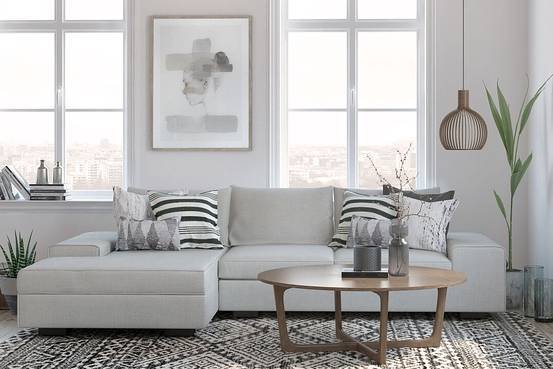Decoding The Eco-Friendly Vs. Sustainable Furniture Debate
Eco-Friendly Vs. Sustainable Furniture Debate: what’s the difference? It’s a question that often arises when we consider making more environmentally conscious choices for our homes. But fear not, the answer is simpler than you might think. Eco-friendly furniture focuses primarily on the materials used in its production, ensuring they have a minimal impact on the environment. On the other hand, sustainable furniture encompasses a broader approach, taking into account the entire lifecycle of the product, from sourcing materials to manufacturing processes and even disposal. In this article, we will delve deeper into the distinctions between these two concepts, clarifying their unique contributions to a greener future for interior design. Let’s explore the fascinating world of eco-friendly and sustainable furniture together.
Eco-Friendly Vs. Sustainable Furniture Debate:
As environmental consciousness continues to grow, people are becoming more concerned about the impact of their choices on the planet. This heightened awareness has led to increased interest in eco-friendly and sustainable products, including furniture. However, there is often confusion about the terms “eco-friendly” and “sustainable” and how they differ. In this article, we will explore the distinction between these two types of furniture and shed light on their significance.
Eco-Friendly Furniture: Making Choices That Minimize Environmental Impact
Eco-friendly furniture refers to products that are designed and manufactured with the goal of minimizing harm to the environment. This approach takes into account the entire lifecycle of the furniture, from sourcing the materials to disposal. Here are some key aspects of eco-friendly furniture:
1. Material Selection: Eco-friendly furniture often utilizes materials that are renewable, recycled, or reclaimed. Examples include sustainably harvested wood, bamboo, recycled plastic, and organic fabrics. These materials help reduce the depletion of natural resources and minimize waste.
2. Production Process: Manufacturers of eco-friendly furniture strive to minimize their carbon footprint by implementing sustainable production practices. This may include using energy-efficient machinery, reducing water consumption, and employing eco-friendly production methods.
3. Non-Toxic Materials: Eco-friendly furniture aims to eliminate or minimize the use of toxic chemicals, such as formaldehyde, VOCs (volatile organic compounds), and flame retardants. This focus on non-toxic materials contributes to a healthier indoor environment for both humans and the planet.
4. Durability and Longevity: Eco-friendly furniture is built to last. By prioritizing durability and quality craftsmanship, manufacturers aim to reduce the need for frequent replacements and minimize waste.
5. Packaging and Transport: Sustainable packaging and shipping practices are integral to eco-friendly furniture. This may involve using recycled or recyclable packaging materials and optimizing logistics to minimize carbon emissions during transportation.
Sustainable Furniture: A Holistic Approach to Long-Term Environmental Impact
While eco-friendly furniture focuses on minimizing harm throughout its lifecycle, sustainable furniture takes a broader perspective. It considers the interplay of social, economic, and environmental factors to ensure long-term viability and harmony with the environment. Here are key features of sustainable furniture:
1. Lifecycle Assessment: Sustainable furniture goes beyond the eco-friendly aspect and conducts a comprehensive lifecycle assessment. This assessment evaluates the environmental impact of the furniture from raw material extraction to disposal, including processes such as manufacturing, transportation, and product use.
2. Ethical Sourcing and Fair Trade: Sustainable furniture often adheres to ethical sourcing practices. This involves ensuring that raw materials are obtained from responsible sources that prioritize workers’ rights, fair wages, and safe working conditions. Additionally, fair trade certification may be sought to support social and economic sustainability.
3. Circular Economy: Sustainable furniture aligns with the principles of a circular economy, aiming to minimize waste and maximize resource efficiency. This may involve utilizing recycled materials, implementing take-back programs, and designing products that can be easily disassembled and recycled at the end of their life cycle.
4. Renewable Energy: To further reduce its environmental impact, sustainable furniture manufacturing often incorporates the use of renewable energy sources, such as solar or wind power.
5. Community Engagement: Sustainable furniture companies often engage with local communities, supporting initiatives that prioritize social, economic, and environmental well-being. This may include community development projects, educational programs, or partnerships with local artisans.
The Intersection of Eco-Friendly and Sustainable Furniture
While eco-friendly and sustainable furniture have distinct focuses, they are not mutually exclusive. In fact, many sustainable furniture options incorporate eco-friendly practices and materials. By combining the two approaches, furniture manufacturers can create products that not only minimize harm but also contribute to the long-term well-being of the planet and its inhabitants.
When searching for eco-friendly and sustainable furniture, it is essential to look for transparency and certifications. Third-party certifications, such as the Forest Stewardship Council (FSC) certification for responsible wood sourcing or GREENGUARD certification for low chemical emissions, can provide assurance that the furniture meets specific standards.
In conclusion, eco-friendly and sustainable furniture both aim to reduce environmental harm, but they approach this goal from slightly different angles. Eco-friendly furniture focuses on minimizing the environmental impact throughout the furniture’s lifecycle, while sustainable furniture takes a more holistic view, considering social, economic, and environmental factors. By understanding the distinctions between these two types of furniture, consumers can make informed choices that align with their values and contribute to a more sustainable future.
- https://www.fsc.org/
- https://www.ul.com/greenguard/
Eco Friendly vs Sustainable Furniture
Frequently Asked Questions
What is the difference between eco-friendly and sustainable furniture?
Eco-friendly and sustainable furniture are often used interchangeably, but they have distinct differences. Eco-friendly furniture refers to products that have minimal negative impact on the environment. It focuses on using renewable materials, non-toxic finishes, and energy-efficient manufacturing processes. On the other hand, sustainable furniture takes a broader approach by considering the entire lifecycle of the product. It aims to minimize waste, promote responsible sourcing, durable construction, and fair working conditions. While eco-friendly furniture emphasizes environmental aspects, sustainable furniture incorporates social and economic factors as well.
How can I identify eco-friendly furniture?
When looking to identify eco-friendly furniture, keep an eye out for certifications such as FSC (Forest Stewardship Council) which ensures the wood is responsibly sourced. Look for labels indicating low or zero VOC (Volatile Organic Compounds) finishes to minimize indoor air pollution. Additionally, check for furniture manufacturers that use recycled or reclaimed materials, sustainable manufacturing practices, and have transparent supply chains.
What are the benefits of eco-friendly furniture?
Eco-friendly furniture offers several benefits. It helps to reduce environmental impact by using renewable materials, conserving natural resources, and reducing waste. It also promotes better indoor air quality by using non-toxic finishes. Additionally, supporting eco-friendly furniture companies encourages sustainable practices and helps create a healthier and greener future for generations to come.
Why is sustainable furniture important?
Sustainable furniture is important because it considers the long-term impact of furniture production and consumption. It aims to reduce waste, promote responsible sourcing of materials, and support fair labor practices. By choosing sustainable furniture, you contribute to a more environmentally friendly and socially responsible industry that prioritizes the well-being of the planet and its inhabitants.
Can furniture be both eco-friendly and sustainable?
Yes, furniture can be both eco-friendly and sustainable. In fact, many furniture companies strive to meet both criteria. Such furniture is designed using renewable materials, eco-friendly manufacturing processes, and sustainable sourcing. It takes into account the entire lifecycle, from raw material extraction to disposal, and aims to minimize environmental impact while also considering social and economic factors.
Are eco-friendly and sustainable furniture more expensive?
Eco-friendly and sustainable furniture can sometimes be more expensive than conventional furniture due to the extra costs associated with environmentally friendly materials and sustainable manufacturing processes. However, the long-term benefits outweigh the initial costs. Investing in eco-friendly and sustainable furniture means supporting responsible practices, reducing environmental impact, and promoting a healthier and more sustainable future.
Final Thoughts
In conclusion, understanding the difference between eco-friendly and sustainable furniture is key to making informed choices for a greener future. While eco-friendly furniture focuses on minimizing negative environmental impacts through the use of materials and production processes, sustainable furniture goes a step further by considering the entire lifecycle of a product and its social and economic implications. By opting for eco-friendly or sustainable furniture, individuals can contribute to the preservation of the environment and support ethical practices in the furniture industry. Making conscious decisions about our furniture choices is vital in creating a more sustainable world.




